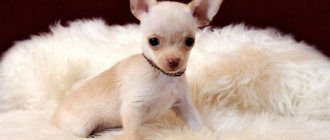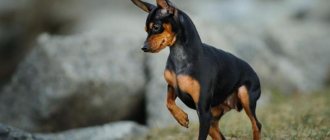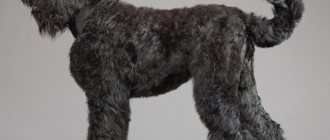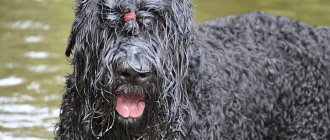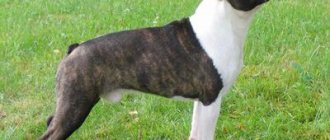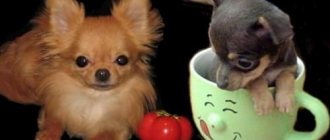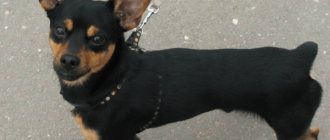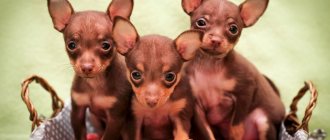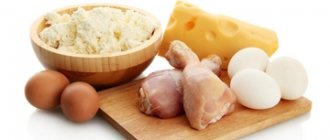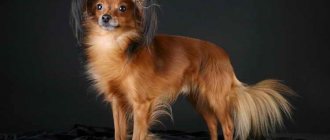Standard color
The ancestors of the Russian Toy Terrier, the English Toy, had only one acceptable color - black and tan. Until the middle of the last century, Russian Toys were only like this, and only occasionally could one meet a brown dog. Beginning in the 70s, this restriction was no longer in force, and brown, brown and tan and red dogs began to participate in exhibitions. Breeders loved colored toys so much that soon other beautiful colors of Russian toy terriers appeared.
About ten genes and two pigments, yellow and black, are responsible for the formation of colors in Russian Toy Terriers. Therefore, the genetics of toy colors is, without exaggeration, confusing, but, nevertheless, very interesting for connoisseurs. In order to somehow predict the colors of the offspring, it is necessary to carefully monitor the pedigree.
Dog care
The Russian Toy Terrier does not require special care and is very easy to maintain. This breed requires vaccination to prevent infectious diseases.
These dogs are easy to care for:
- regularly examine your eyes and, if necessary, rinse accumulated secretions with a cotton swab dipped in water;
- examine your ears every month, make sure that there is no unpleasant odor from the auricle, and that wax does not accumulate in it;
- trim the tips of the claws monthly - if they are too long, they can curl up or painfully dig into soft tissues;
- pay attention to the anal glands - if they are overcrowded, dogs begin to fidget and scratch their butts on carpets or grass, you need to free the gland from the accumulated secretion, pressing little by little with your fingers on the sides of the anus.
The Russian Toy Terrier rises by the chest, covering it with his palm over the entire surface. Such dogs should be carefully released from your arms and not placed on high sofas or chairs. Jumping from a height can damage its paws. It is strictly forbidden to pick up terriers by the stomach, paws or armpits.
Blue and lilac toy terriers
Among the genes of Russian Toy Terriers there is a recessive gene that weakens color. It seems to blur the colors in the animal’s fur and lighten the skin color. Black toys with this gene are born grayish-blue, and brown ones acquire a special reddish-blue tint, which among experts is usually called lilac.
Blue and purple toys are very beautiful animals with a light watercolor tint. These colors are influenced by other genes and may have tan like the standard ones. Both plain and tan animals are highly valued and expensive.
History of the breed
The Russian Toy Terrier is a decorative dog breed that was bred in Russia in the 50s of the last century. The breed was purposefully obtained by dog handlers by mixing several types of small dogs. The work carried out made it possible to create a stable breed, which is registered as an independent breed with characteristic characteristics. Moreover, these characteristic features are passed on from generation to generation, which gives the right to talk about the presence of a Russian toy terrier (more precisely, a Russian toy).
First, a smooth-haired toy terrier (photo) was bred, and then, through experiments with representatives of this breed, a long-haired Russian toy terrier (photo attached). In accordance with the international classification, the Russian toy received the number 352, including both varieties. Through selective selection, a super-small dog was also obtained - a mini Russian Toy Terrier (the photo shows the dog).
White toy terrier
Historically, Toy Terriers have always been colored. The completely white color of the Russian Toy Terrier is considered a disadvantage and a reason for disqualification. White Toy cannot participate in exhibitions and is excluded from breeding. But if you fall in love with a snow-white puppy, what will stop you from becoming his loving owner?
- Like
- COMMENTS
- |
- leave a comment
- |
- Add to favorites 0
Differences between Russian Toy Terriers and English ones
After the revolution at the beginning of the 20th century, the population of this species decreased greatly and only by the middle of the last century began to gain particular popularity again. The impossibility of mating with representatives of the breed from abroad led to the fact that Russia developed its own breed standard, which was called the Russian Toy Terrier.
These dogs differed from their ancestors in their shorter height, as well as a variety of colors from black and tan to any shade of blue or red. In the English breed, only black color varieties are allowed. And the main feature of the Russian Toy breed was the structure of the head with a high convex forehead and a very sharp characteristic transition from the forehead to a short, sharp muzzle.
Foreign analogues have a head in the form of a narrow wedge with a characteristic flat forehead and an elongated, narrow profile of the muzzle, well filled under the eyes.
In 1965, a draft standard for the Russian Toy breed was approved. In 2006, the breed was officially registered by the International Canine Organization.
External features of the breed
The Russian Toy Terrier is a small dog with increased mobility, high thin legs and lean muscles. The legs are almost straight and parallel. The tail is usually docked to 2 vertebrae. The head is light, wedge-shaped and set on a fairly long, gracefully bent neck. The cranial area of the head is expanded and has a pronounced roundness. The frontal area is wide and slightly convex. The muzzle, as a rule, is 1/3 the length of the head. The ears are triangular in shape with pointed or rounded tips, mobile, quite thin and erect.
As noted, there are 2 main varieties of the breed. The Russian Smooth-haired Toy Terrier has short fur without undercoat or bald spots. The wool fits tightly and has an attractive shine. The longhaired Russian Toy Terrier is distinguished by the length of its coat, which reaches 4-6 cm. It can be either straight or wavy, but does not hide the natural contours of the body. On the paws, the claw area is covered with elongated hair. The ears are marked by a fringe of long, thick hair, which is a distinctive feature of this type of dog.
The color of toy terriers can have several shades, but all colors are very rich. The following colors are distinguished: black-fawn, brown-fawn, isabella-fawn, fawn, red of various shades with a touch of black or brownish color.
The size of an adult dog, regardless of gender, is 21-29 cm at the withers. The Mini Russian Toy Terrier measures less than 20 cm. The weight of an adult Toy reaches 3.2 kg. How long do Russian toy terriers live? Long-term observations show that their average life expectancy is 13-16 years.
Marriage or breed?
The English Toy and Russian Toy Terrier are related breeds that have similar origins..
The Russian subspecies has a number of genetic differences, since different breeds and even mongrels participated in the appearance of this breed.
A pure white toy terrier without tan will be considered a marriage..
Expert opinion
Kozhevin Semyon Kirillovich
Expert dog handler.
With proper training, toy terriers are well socialized. They get along well with children, cats and other dogs. This breed has perfect hearing. If not properly cared for, the animal may get sick. They have rather fragile bones, so a strong jump can cause a fracture.
Brief history of origin
It’s worth starting with the fact that the breed has another name – Russian Terrier. Indeed, the first toy terrier was bred in Russia. And even before the revolution, at the very beginning of the twentieth century. Miniature and cheerful, they were liked by many aristocrats and milliners.
Fact! The first long-haired Russian Toy Terrier appeared in 1958 as a result of crossing smooth-haired parents.
True, in the 20-50s the breed almost disappeared completely. The fact is that it was popular only in Russia. Only a few copies were exported abroad. Because of the outbreak of the revolution, and then the Great Patriotic War, people had no time for miniature dogs.
However, in the middle of the twentieth century, some dog handlers who preferred decorative pets began to work again. And they managed to cope with the difficult task of breeding an almost extinct breed. The experts made a lot of effort and their work was crowned with success - the Russian toy terrier was saved.
Caring for Toy Terriers
In general, keeping these dogs is quite simple and rarely causes any serious problems. But still, it will be very useful to understand some points. After all, even minor mistakes can lead to the dog getting sick often and not living as long and happy a life as it could.
Diet of toy terriers
Of course, you can use inexpensive dry food for feeding, but in this case there is a risk of food allergies and other health problems. Therefore, experienced breeders prefer to create their own diet. Yes, it is more difficult and troublesome. But in this case, the owner can be sure that his beloved dog receives all the necessary micro- and macroelements, as well as vitamins.
Carrots are very healthy
Conventionally, the entire diet can be divided into three parts:
- Meat (70%) - beef, chicken, sea fish, and sometimes offal are suitable. It is better to give it raw - this way more nutrients will be preserved. But many breeders prefer to boil the meat to disinfect it.
- Porridge (10%) – buckwheat, oatmeal, millet and wheat cooked in meat broth are an excellent choice.
- Vegetables and fruits (20%) - the easiest way is to take carrots, zucchini or pumpkin and grate them on a fine grater, then add them to the porridge.
You can also add vitamin complexes to your diet, which are sold at any pet store. Before giving any vitamin complexes, you should consult your veterinarian.
With this diet, the dog receives not only a tasty, but also a completely balanced diet, thanks to which he will feel happy and live for many years to the delight of his owners.
Place for a toy terrier puppy
Despite its small size, the toy terrier is amazingly independent. And he needs to have his own corner where he can always relax and be alone. Therefore, as mentioned above, it is advisable to choose a place where the owners do not pass by and disturb the pet.
Amazingly active pet
A small basket or even a kennel would be a great choice. It can be made from plywood or cardboard box. The main thing is that the house is not too big - about one and a half times larger than the dog. Then the pet will feel as comfortable and safe as possible. The bottom can be covered with a soft rag or, even better, with the owner’s old sweater, so that his smell is always nearby.
You can equip the place both in the bedroom and in the corridor. And all family members, including children, should know that the dog cannot be pulled out of there - this is her and only her territory.
Yes, in the first days there is a temptation to take the toy terrier puppy to bed at least for the night. After all, he whines so pitifully, left without his mother and brothers and sisters. I want to surround the baby with love and care, give a feeling of peace. But once you let him sleep with his owner, it will be almost impossible to wean him off.
Breed standard and what purebred dogs look like
Of course, before you get a mini toy terrier dog at home, you should study the breed standard. This will help you decide whether it is worth getting just such a pet or whether it makes sense to give preference to other breeds.
We should start with the fact that it was not by chance that the mini terrier began to be called that. He is truly surprisingly miniature - at the withers an average of 20 to 28 cm with a weight of 2.5-3 kg. Of course, a Tor Terrier will easily fit in the arms of even a child.
The dog's legs are quite long, but thin. Moreover, their miniature size does not at all prevent the dogs from being quite strong - their muscles are dry and well developed, which ensures mobility and speed.
Long-haired dog
When describing a toy terrier, one cannot fail to mention the coat. Today there are two standards - smooth-haired and long-haired. The former have shiny, very short fur, lying close to the body. The second has a longer length, up to 5 mm. Also adjacent to the body, it can be either straight or slightly wavy. In any case, the hairline should be even, without bald spots and smooth.
Of course, speaking about toy dogs, it is worth mentioning the acceptable color options. They are quite numerous and varied:
- red (can be diluted with brown, chocolate and black coating);
- pale yellow;
- black tan;
- lilac tan;
- blue and tan;
- brown tan.
If the color contains white, this is a defect. However, a non-specialist may well confuse a Russian toy terrier with an American one (its generally correct name is toy fox terrier), for which white color is one of the standards.
What can affect your dog's health?
Health problems arise quite often in dogs of dwarf breeds, which requires careful attention to their maintenance. The danger comes from various injuries, viral infections, overheating and hypothermia. In Toy Terriers, the following organs are most susceptible to disease: skeletal system, teeth, skin, pancreas, cardiovascular system. What problems do you encounter most often?
The following can be distinguished:
- Tooth loss associated with the eruption of molars occurs at the age of 5-6 months. Sometimes baby teeth do not want to fall out on their own, and then the help of a veterinarian is necessary.
- Fractures and dislocations are a common occurrence in toy terriers. The dog should not be allowed to fall or jump from a height of more than 35-45 cm. The dog should not be raised to a height that it itself cannot handle.
- Dogs are easily susceptible to colds. Drafts should not be allowed, especially when the dog is wet. In frosty weather, the Toy Terrier must be dressed warmly.
- Toy terriers are susceptible to ear pathologies and cataracts. Such diseases should be detected promptly.
The most effective way to ensure the health of your pet is timely vaccination. The first vaccination (BIOVAC) is given at the age of 2.5-3 months, and then after 10-12 days. Repeated vaccination is carried out at the age of 7-9 months, after which a mandatory rabies vaccination is given. It is also important to give your dog anthelmintics in a timely manner. They should be given 3-4 times a year.
Russian Toy Terriers have gained immense popularity due to their miniature size, decorativeness and loyalty. Their maintenance does not require special conditions, but basic rules must be followed.
What are the main differences between the breed
The most commonly considered dogs are confused with their English counterparts. When the Russian Toy Terrier and the Toy Terrier are considered, the differences can be easily detected. The Russian Toy has a height of up to 29 cm and a weight of up to 3.2 kg, and can have 2 varieties: smooth-haired and long-haired. The English Toy Terrier can reach 32 cm and weigh 3.6-3.8 kg. He can only have short hair.
The Russian Toy is significantly superior to the English Toy Terrier in terms of agility. Its English counterpart has a consistent character that does not lead to excesses. The breed has recently lost a lot of popularity.
It is easy to confuse the Russian variety with the Prague rat dog, which also belongs to this type of dog. When comparing the Prague rat and the Russian toy terrier, the differences are subtle, but upon close comparison they are quite noticeable by eye. The rat looks more powerful: it has a larger head, an elongated pear-shaped head, the muscle structure is more pronounced, and the joints are pointed, while the size of the dog is slightly smaller than that of the toy terrier (no more than 22 cm), and the weight reaches 2.7-2 .8 kg. In other words, the Prague rat is a robust breed that is widespread in Europe.

